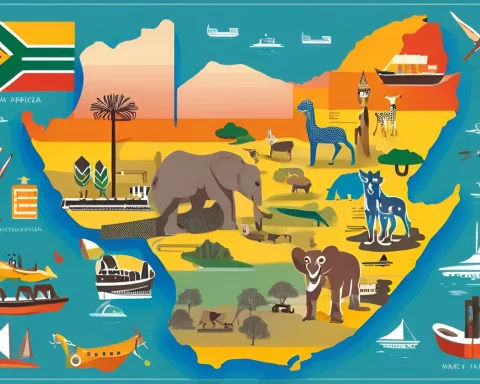South Africa’s National Tourism Safety Strategy (NTSS) is a threefold approach to address safety concerns in the tourism industry. The strategy includes preventative actions, responsive actions, and follow-up programs to enhance the visitor experience and shift perceptions of South Africa as an unsafe destination. Measures such as a Crisis Management Communications Plan, partnerships with law enforcement, and the deployment of Tourism Monitors to key attractions and sites aim to facilitate the practical implementation of the NTSS. The overall goal of the strategy is to safeguard both domestic and international tourists, alter perceptions about South Africa as a destination, and secure its position as an appealing and safe destination for tourists worldwide.
What is South Africa’s National Tourism Safety Strategy?
The National Tourism Safety Strategy (NTSS) is a collaborative effort between the South African government and private sector to address safety concerns within the tourism industry. Its threefold approach includes preventative actions, responsive actions, and follow-up programs aimed at enhancing the visitor experience and shifting perceptions of South Africa as an unsafe destination. The strategy includes measures such as a Crisis Management Communications Plan, partnerships with law enforcement, and the deployment of Tourism Monitors to key attractions and sites.
A Strategic Response to Tourism Safety Concerns
In the current era marked by increasing global interconnectedness, the attraction of travel and tourism has never been so compelling. However, this global curiosity also brings about a heightened sensitivity and apprehension towards safety. South Africa has acknowledged this crucial element of the tourism industry, and in response, has formulated a broad National Tourism Safety Strategy (NTSS). The aim of the NTSS is to establish a cooperative platform between the public and private sectors to tackle safety concerns within the tourism industry.
The NTSS is founded on three principal components: preventative actions, responsive actions, and follow-up programs. The objective of this threefold strategy is to give tourists a sense of security even before they commence their journey to South Africa.
The South African Minister of Tourism, Patricia de Lille, aptly encapsulated the purpose of this strategy. She stated that the NTSS seeks to “enhance the visitor experience and ultimately shift perceptions of South Africa as an unsafe destination”. The minister underscored the value of stakeholder collaboration and communication, asserting that the NTSS is committed to “implementing mechanisms to ensure swift and effective aid to tourists in distress should a crime occur.”
Instituting Safety Measures and Partnerships
To facilitate this, the Tourism Business Council of South Africa (TBCSA) has set up a committee responsible for creating a clear Crisis Management Communications Plan and Protocols. These protocols are designed to provide explicit procedures during a crisis, ensuring that the response is coordinated, consistant, and effective.
The NTSS has also reached an important milestone with the signing of a Memorandum of Understanding (MoU) with the South African Police Services (SAPS). This alliance underlines the commitment to prevent, investigate, and combat crimes which impact the tourism industry, and guarantee the safety and well-being of tourists. The MoU is dynamic and open to changes that incorporate other private sector initiatives aimed at strengthening safety and security.
Real-World Implementation and the Role of the Tourism Monitors Program
A crucial component of the NTSS’s practical application is the Tourism Monitors Program (TMP). This initiative reflects the wider government intervention that involves training, mentorship, and deployment of unemployed youth at identified tourism attractions and sites. The government has allocated a substantial R174 million for the deployment of Tourism Monitors in the current fiscal year.
The primary goals of the TMP are multifold. It seeks to enhance tourism safety awareness at key attractions and sites, offer vocational training to unemployed youth, and minimize tourist vulnerabilities. The program plans to deploy 2,300 Tourism Monitors across South Africa. These monitors will be located at entities managed by South African National Biodiversity Institute (SANBI) Gardens, iSimangaliso Wetland Park, Ezemvelo Nature Reserve, national parks managed by South African National Parks (SANParks), and airports managed by Airports Company South Africa (ACSA).
In summary, the National Tourism Safety Strategy is a collaborative effort by the South African government and private sector to safeguard both domestic and international tourists. It marks a significant step towards altering perceptions about South Africa as a destination and securing its position as an appealing and safe destination for tourists worldwide. With its combination of proactive, responsive, and aftercare measures, along with a strong focus on stakeholder collaboration and communication, the NTSS presents a hopeful strategy for tourism safety both within and beyond South Africa’s borders.
1. What is South Africa’s National Tourism Safety Strategy?
The National Tourism Safety Strategy (NTSS) is a collaborative effort between the South African government and private sector to address safety concerns within the tourism industry. Its threefold approach includes preventative actions, responsive actions, and follow-up programs aimed at enhancing the visitor experience and shifting perceptions of South Africa as an unsafe destination. The strategy includes measures such as a Crisis Management Communications Plan, partnerships with law enforcement, and the deployment of Tourism Monitors to key attractions and sites.
2. How does the NTSS aim to enhance the visitor experience?
The NTSS aims to enhance the visitor experience by providing tourists with a sense of security even before they commence their journey to South Africa. The strategy includes measures such as a Crisis Management Communications Plan, partnerships with law enforcement, and the deployment of Tourism Monitors to key attractions and sites.
3. What is the role of the Crisis Management Communications Plan?
The Crisis Management Communications Plan is a protocol designed to provide explicit procedures during a crisis, ensuring that the response is coordinated, consistent, and effective. The plan is created by the Tourism Business Council of South Africa (TBCSA) to facilitate a swift and effective aid to tourists in distress should a crime occur.
4. What is the Memorandum of Understanding (MoU) signed by the NTSS?
The MoU is a partnership agreement between the South African Police Services (SAPS) and the National Tourism Safety Strategy (NTSS). It is designed to prevent, investigate, and combat crimes that impact the tourism industry, and guarantee the safety and well-being of tourists. The MoU is dynamic and open to changes that incorporate other private sector initiatives aimed at strengthening safety and security.
5. What is the Tourism Monitors Program?
The Tourism Monitors Program (TMP) is an initiative of the wider government intervention that involves training, mentorship, and deployment of unemployed youth at identified tourism attractions and sites. The primary goals of the TMP are to enhance tourism safety awareness, offer vocational training to unemployed youth, and minimize tourist vulnerabilities. The program plans to deploy 2,300 Tourism Monitors across South Africa.
6. What are some of the attractions and sites where Tourism Monitors will be deployed?
Tourism Monitors will be located at entities managed by South African National Biodiversity Institute (SANBI) Gardens, iSimangaliso Wetland Park, Ezemvelo Nature Reserve, national parks managed by South African National Parks (SANParks), and airports managed by Airports Company South Africa (ACSA).












